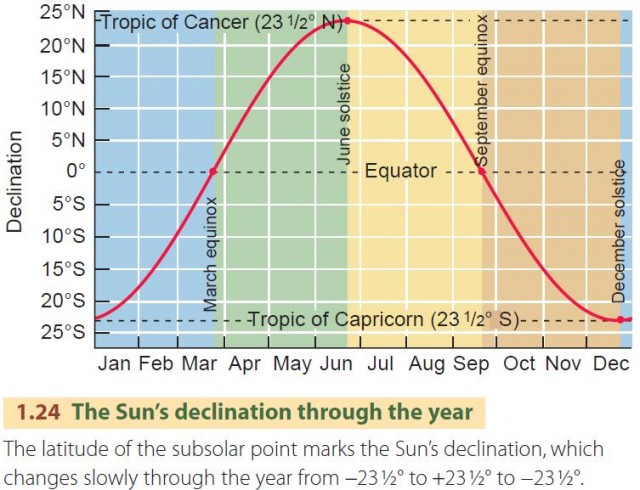The Earth’s Revolution around the Sun
So far, we have discussed the importance of the Earth's rotation on its axis. But what about the Earth's movement as it orbits the Sun? We refer to this motion as the Earth's revolution around the Sun. The Earth takes 365.242 days to travel around the Sun—almost a quarter of a day longer than the calendar year of 365 days. Every four years, this time adds up to nearly one extra day, which we account for by inserting a 29th day into February in leap years. Further minor corrections—such as omitting the extra day in century years—are necessary to keep the calendar on track.
The Earth's orbit around the Sun is shaped like an ellipse, or oval (Figure 1.17 ). This means that the distance between the Earth and Sun varies somewhat through the year. The Earth is nearest to the Sun at perihelion , which occurs on or near January 3. It is farthest away from the Sun at aphelion , on or near July 4. However, the distance between Sun and Earth varies only by about 3 percent during one revolution because the elliptical orbit is shaped very much like a circle. For most purposes we can regard the orbit as circular. Which way does the Earth revolve? Imagine yourself in space, looking down on the North Pole. From this viewpoint, the Earth travels counterclockwise around the Sun (Figure 1.18 ). This is the same direction as the Earth's rotation.
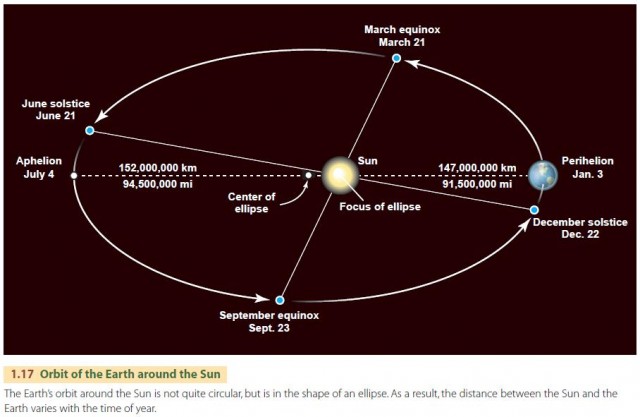
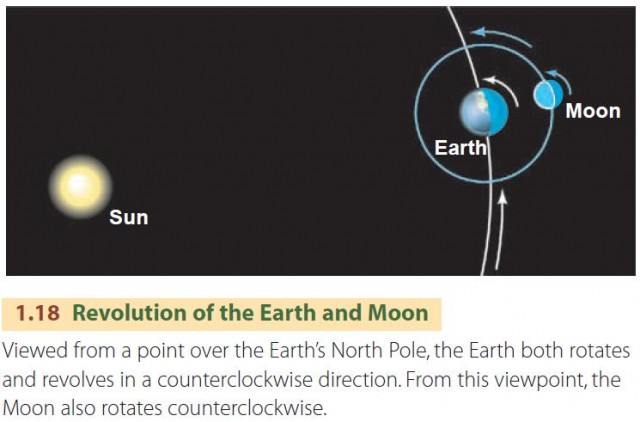
MOTIONS OF THE MOON
The Moon rotates on its axis and revolves about the Earth in the same direction as the Earth rotates and revolves around the Sun. But the Moon's rate of rotation is synchronized with the Earth's rotation so that one side of the Moon is permanently directed toward the Earth while the opposite side of the Moon remains hidden. It was only when a Soviet spacecraft passing the Moon transmitted photos back to Earth in 1959 that we caught our first glimpse of the far side.
The phases of the Moon are determined by the position of the Moon in its orbit around the Earth, which in turn determines how much of the sunlit Moon is seen from the Earth. It takes about 29.5 days for the Moon to go from one full Moon to the next. In the twilight photo of a moonlit scene in Figure 1.19 , the Moon is nearly full. From the way that the Sun illuminates the Moon as a sphere, it is easy to see that the Sun is down and to the right.
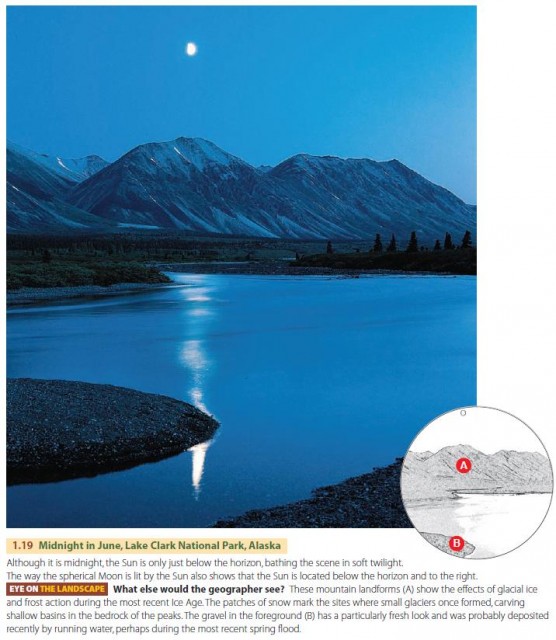
TILT OF THE EARTH'S AXIS
Depending on where you live in the world, the effects of the changing seasons can be large. But why do we experience seasons on Earth? And why do the hours of daylight change throughout the year—most extremely at the poles, and less so near the Equator? Seasons arise because the Earth's axis is not perpendicular to the plane containing the Earth's orbit around the Sun, which is known as the plane of the ecliptic. Figure 1.20 shows this plane as it intersects the Earth.
If we extend the imaginary axis out of the North Pole into space, it always aims toward Polaris, the North Star. The direction of the axis does not change as the Earth revolves around the Sun. Let's investigate this phenomenon in more detail.
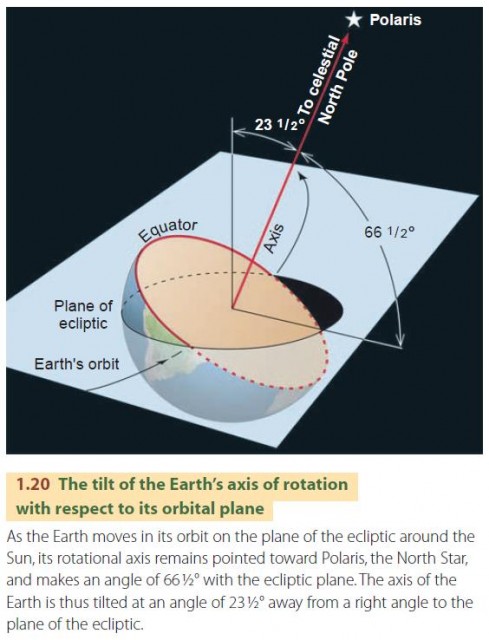
THE FOUR SEASONS
Figure 1.21 shows the full Earth orbit traced on the plane of the ecliptic. On December 22, the north polar end of the Earth's axis leans at the maximum angle away from the Sun, 23 ?°. This event is called the December solstice , or winter solstice in the northern hemisphere. At this time, the southern hemisphere is tilted toward the Sun and enjoys strong solar heating.
Six months later, on June 21, the Earth has traveled to the opposite side of its orbit. This is known as the June solstice , or summer solstice in the northern hemisphere. The north polar end of the axis is tilted at 23 ?° toward the Sun, while the South Pole and southern hemisphere are tilted away. The equinoxes occur midway between the solstice dates. At an equinox, the Earth's axis is not tilted toward the Sun or away from it. The March equinox (vernal equinox in the northern hemisphere) occurs near March 21, and the September equinox (autumnal equinox) occurs near September 23. The conditions at the two equinoxes are identical as far as the Earth–Sun relationship is concerned. The date of any solstice or equinox in a particular year may vary by a day or so, since the revolution period is not exactly 365 days.
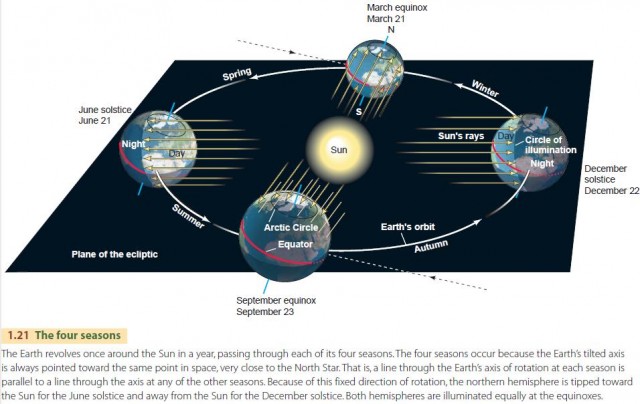
EQUINOX CONDITIONS
The Sun's rays always divide the Earth into two hemispheres—one that is bathed in light and one that is shrouded in darkness. The circle of illumination is the circle that separates the day hemisphere from the night hemisphere. The subsolar point is the single point on the Earth's surface where the Sun is directly overhead at a particular moment.
At equinox, the circle of illumination passes through the North and South Poles, as we see in Figure 1.22. The Sun's rays graze the surface at both poles, so the surfaces at the poles receive very little solar energy. The subsolar point falls on the Equator. Here, the angle between the Sun's rays and the Earth's surface is 90°, so that point receives the full force of solar illumination. At noon at latitudes in between, such as 40° N, the Sun strikes the surface at an angle that is less than 90°. The angle that marks the Sun's elevation above the horizon is known as the noon angle. Simple geometry shows that for equinox conditions the noon angle is equal to 90° minus the latitude, so that at 40° N, the noon angle is 50°.
One important feature of the equinox is that day and night are of equal length everywhere on the globe. You can see this by imagining yourself located at a point on the 40° N parallel. As the world turns, you will be in daylight for exactly half the day and in night for the other half.

SOLSTICE CONDITIONS
Now let's examine the solstice conditions in Figure 1.23. The June solstice is shown on the left. Imagine that you are back at a point on the lat. 40° N parallel. Unlike at equinox, the circle of illumination no longer divides your parallel into equal halves because of the tilt of the northern hemisphere toward the Sun. Instead, daylight covers most of the parallel, with a smaller amount passing through twilight and darkness. For you, the day is now considerably longer (about 15 hours) than the night (about 9 hours). Now step onto the Equator. You can see that this is the only parallel that is divided exactly into two. On the Equator, daylight and nighttime hours will be equal throughout the year.
The farther north you go, the more the effect increases. Once you move north of lat. 66 ?°, the day con tinues unbroken for 24 hours. Looking at Figure 1.23 , we can see that is because the lat. 66 ?° parallel is positioned entirely within the daylight side of the circle of illumination. This parallel is known as the Arctic Circle. Even though the Earth rotates through a full cycle during a 24-hour period, the area north of the Arctic Circle will remain in continuous daylight. We can also see that the subsolar point is at a latitude of 23 ?° N. This parallel is known as the Tropic of Cancer. Because the Sun is directly over the Tropic of Cancer at this solstice, solar energy is most intense here.
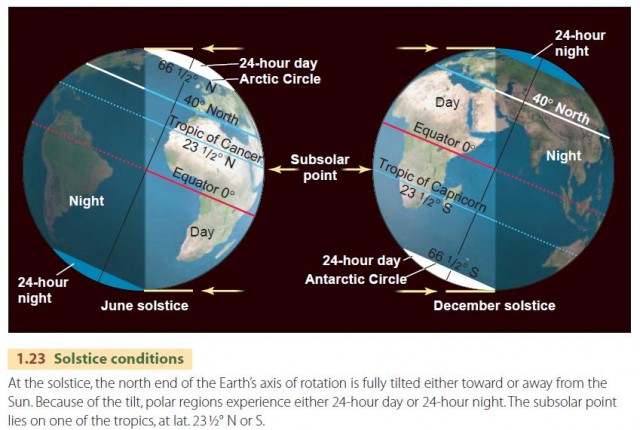
The conditions are reversed at the December solstice. Back at lat. 40° N, the night is about 15 hours long, while daylight lasts about 9 hours. All the area south of lat. 66 ?° S lies under the Sun's rays, inundated with 24 hours of daylight. This parallel is known as the Antarctic Circle. The subsolar point has shifted to a point on the parallel at lat. 23 ?° S, known as the Tropic of Capricorn.
We have carefully used the term daylight to describe the period of the day during which the Sun is above the horizon. When the Sun is not too far below the horizon, the sky is still lit by twilight. At high latitudes during the polar night, twilight can be several hours long and provide enough illumination for many outdoor activities.
The solstices and equinoxes are four special events that occur only once during the year. Between these times, the latitude of the sub solar point travels northward and southward in an annual cycle, looping between the Tropics of Cancer and Capricorn. We call the latitude of the subsolar point the Sun's
declination (Figure 1.24 ). As the seasonal cycle pro gresses, the polar reg ions that are bathed in 24-hour daylight or shadowed in 24-hour night shrink and then grow. At other latitudes, the length of daylight changes slightly from one day to the next, except at the Equator, where it remains the same. In this way, the Earth experiences the rhythm of the seasons as it continues its revolution around the Sun.
